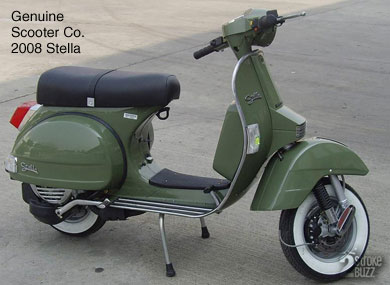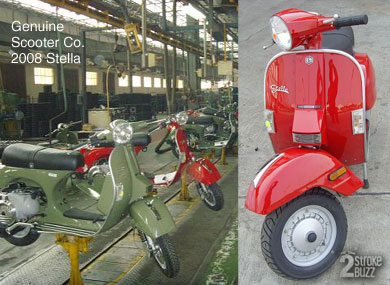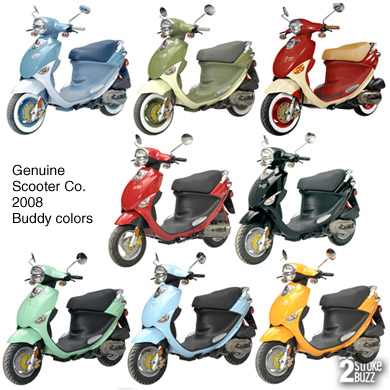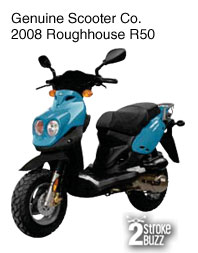(Updated 11:30pm 11/29/07 with photos and more details.)

The news we’ve all been waiting for, and a couple surprises: The first shipment of Genuine Stellas (reportedly less than 300 scooters) will be delivered in January to top-seller Genuine dealers only, who will get 15 Stellas each (3 of each color per dealer: avocado, powder blue, red, tangerine, and black). As reported earlier, Scooterworks USA and some other dealers are accepting pre-orders. $3399 is the official MSRP.

The second batch is due from India in May. Not much detail is available on improvements, An email sent to Scooterwork customers called the Grimeca front discs “new”, so it’s unclear whether the Indian-market licensed Grimecas on older Stellas have been replaced with “real” Grimecas, or if they’ve just been improved somehow. Engine internals (notably the crank and bearings) have reportedly been upgraded. In the factory photo above, the ignition/CDI appears to have been relocated, though it’s possible it’s simply not mounted yet. Tires have been upgraded to Continental Zippy 1s, with whitewalls standard on the Avocado Stella. We’ve found nothing to indicate that the new Stellas will meet California emissions regulations, but John Gerber (see comments below) reports that LML is likely to develop a manual-transmission 4-stroke engine in 2008 (and may unveil an ET4 clone as early as next month!).

Other big Genuine news: the 2008 Buddy line will feature three “International” Editions with 150cc engines (yes, 150cc, that’s not a typo) at an MSRP of $2,999. The first is the two-tone green “Series Italia” as seen in 2006, the two new models are “Saint-Tropez” in french blue and dove grey with a navy seat, and the “Pamplona” in Beige and Red with a tan seat. These two models are as distinctive and stunning (if not more so) than the Italia, and the idea of a Buddy with a 150cc engine (and a new Stebel airhorn standard) is nearly frightening. The Series Italia will also be available in a limited-edition 50cc edition at $1999. The 50 and 125cc Buddies remain pretty much the same, but with new colors: seafoam, powder blue, tangerine (looks yellow in photos), red, and black. 50ccs are $1899, 125s are $2599. A limited quantity of pink Buddy 50s and 125s may be available from some of Genuine’s higher-volume dealers.
 The Blur 150 is gone, no surprise there, though 2sb owns and loves it, it hasn’t sold well, dealers are heavily discounting the ’06 orange and charcoal Blur 150s, and there seems to be no shortage of the ’07 black and charcoal model. The Black Cat has also been discontinued, but again, you’ll have no problem finding one. The Rattler 110 is back in red and silver, and it has a surprise new little brother, the MSRP $1850 Roughhouse R50 in green or blue. The R50 appears to be Genuine’s rebranding of the PGO PMX 50 (the Rattler 110 is the PMX 110 “Naked”) and it will likely sell much better than the too-gaudy Black Cat. (and, Genuine hopes, put up some competition for the reborn and newly-popular Yamaha Zuma). It is unclear when the new Buddys and the Roughhouse will arrive on our shores.
The Blur 150 is gone, no surprise there, though 2sb owns and loves it, it hasn’t sold well, dealers are heavily discounting the ’06 orange and charcoal Blur 150s, and there seems to be no shortage of the ’07 black and charcoal model. The Black Cat has also been discontinued, but again, you’ll have no problem finding one. The Rattler 110 is back in red and silver, and it has a surprise new little brother, the MSRP $1850 Roughhouse R50 in green or blue. The R50 appears to be Genuine’s rebranding of the PGO PMX 50 (the Rattler 110 is the PMX 110 “Naked”) and it will likely sell much better than the too-gaudy Black Cat. (and, Genuine hopes, put up some competition for the reborn and newly-popular Yamaha Zuma). It is unclear when the new Buddys and the Roughhouse will arrive on our shores.
Genuine is offering nothing over 150cc, which is interesting because Kymco is really focusing on that market these days. It may hurt Genuine in the short run as Buddy owners look to step up, but a couple dealers have suggested to 2sb that Kymco may have bit off more than they could chew in the maxi-scooter market. Maybe PGO (and thus, Genuine) is wise to focus on what they do best. PGO’s focused on the Asian market where most bikes are under 150, but a 250cc scooter from Genuine would probably keep a lot of their U.S. customers off Kymcos. (Interestingly, the Blur (PGO G-Max) 200 was rumored to be sort of a dud, and PGO appears to have discontinued their 250cc G-Max.)

